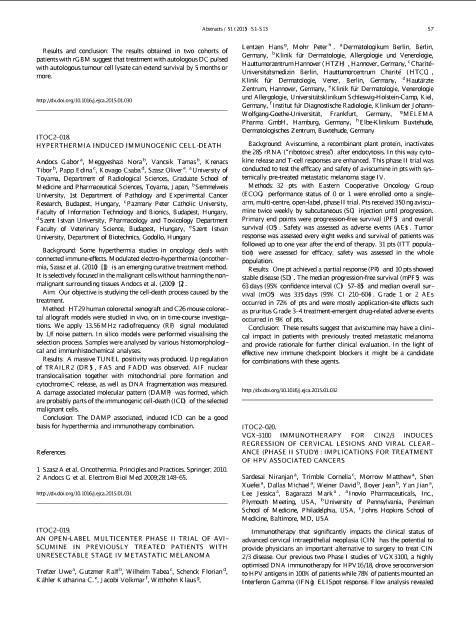
暂无数据~
ITOC2 – 018. Hyperthermia induced immunogenic cell-death 
Background Some hyperthermia studies in oncology deals with connected immune-effects. Modulated electro-hyperthermia (oncothermia, Szasz et al. (2010) [1]) is an emerging curative treatment method. It is selectively focused in the malignant cells without harming the non-malignant surrounding tissues Andocs et al. (2009) [2]. Aim Our objective is studying the cell-death process caused by the treatment. Method HT29 human colorectal xenograft and C26 mouse colorectal allograft models were studied in vivo, on in time-course investigations. We apply 13.56 MHz radiofrequency (RF) signal modulated by 1/f noise pattern. In silico models were performed visualising the selection process. Samples were analysed by various histomorphological and immunhistochemical analyses. Results A massive TUNEL positivity was produced. Up regulation of TRAILR2 (DR5), FAS and FADD was observed. AIF nuclear translocalisation together with mitochondrial pore formation and cytochrome-C release, as well as DNA fragmentation was measured. A damage associated molecular pattern (DAMP) was formed, which are probably parts of the immunogenic cell-death (ICD) of the selected malignant cells. Conclusion The DAMP associated, induced ICD can be a good basis for hyperthermia and immunotherapy combination.

Packing Density of the Amyloid Precursor Protein in the Cell Membrane 
Abstract Plasma membrane proteins organize into structures named compartments, microdomains, rafts, phases, crowds, or clusters. These structures are often smaller than 100 nm in diameter. Despite their importance in many cellular functions, little is known about their inner organization. For instance, how densely are molecules packed? Being aware of the protein compaction may contribute to our general understanding of why such structures exist and how they execute their functions. In this study, we have investigated plasma membrane crowds formed by the amyloid precursor protein (APP), a protein well known for its involvement in Alzheimer’s disease. By combining biochemical experiments with conventional and super-resolution stimulated emission depletion microscopy, we quantitatively determined the protein packing density within APP crowds. We found that crowds occurring with reasonable frequency contain between 20 and 30 molecules occupying a spherical area with a diameter between 65 and 85 nm. Additionally, we found the vast majority of plasmalemmal APP residing in these crowds. The model suggests a high molecular density of protein material within plasmalemmal APP crowds. This should affect the protein’s biochemical accessibility and processing by nonpathological α-secretases. As clustering of APP is a prerequisite for endocytic entry into the pathological processing pathway, elucidation of the packing density also provides a deeper understanding of this part of APP’s life cycle.


暂无数据~

 V2
V2
